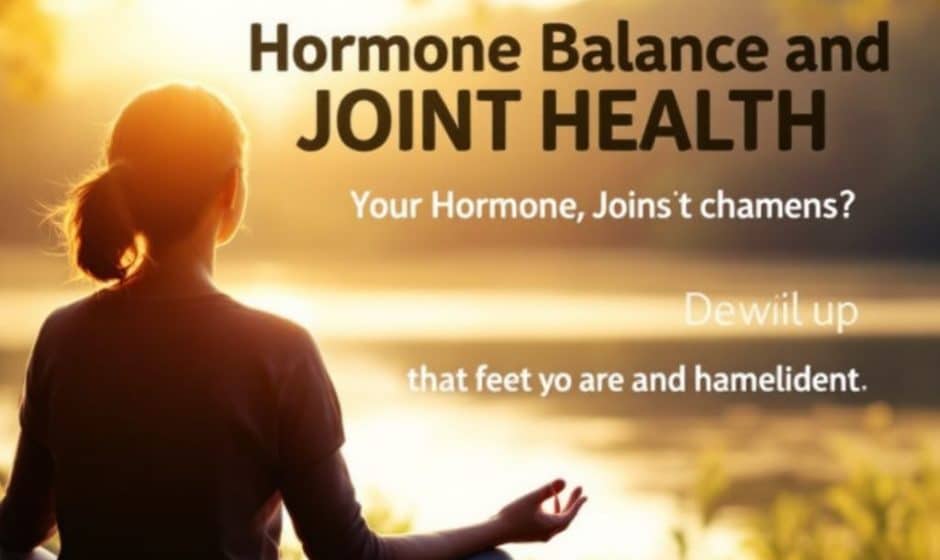So, you’ve woken up with aching joints again, huh? You’re not alone—millions feel your pain. Literally. Arthritis has this way of making a picnic feel like you’re hauling rocks, and even brushing your teeth can feel like a workout. But, here’s the twist, it might not just be your joints that need attention. Nope, there’s more going on beneath the surface. We’re talking hormones. Yep, those little messengers in your body play a huge role in joint health, and today, we’re diving into hormone regulation and how it might just save your day—or at least make your mornings a bit easier.
What’s All This About Hormones, Anyway?
Alright, let’s cut through the jargon. Hormones are like the body’s text messages, bouncing signals around to keep you functioning properly. They’re essential when we’re talking about arthritis. Wondering how? Well, hormones impact inflammation, pain perception, and even how your body repairs stuff—critical players in the realm of joint health.
Hormones and Inflammation: The Sticky Link
Let’s break down inflammation first. It’s that thing your body does when it’s fighting something a bit off. With arthritis, this response goes into overdrive. Enter hormones: your body uses various hormones like cortisol (ever heard of the fight or flight response hormone?) and others to regulate this inflammation. When they’re out of whack, your poor joints might start screaming at you to pay attention.
Estrogen and Testosterone: More Than Meets the Eye
Here’s something you didn’t know you needed to know. Estrogen and testosterone aren’t just busy doing their usual gender-related tasks. They also contribute to bone health and inflammation control. For instance, women often experience increases in arthritis symptoms post-menopause. You guessed it—this happens primarily because of plummeting estrogen levels. Crazy, right?
How Are Hormone Levels Disrupted?
So, what’s causing this hormonal messy business? Several lifestyle factors could be interfering with hormone regulation.

- Stress: Not just a mental game. Chronic stress keeps your cortisol pumped, throwing everything out of whack.
- Diet: Your meal choices can tilt the scales on hormone production.
- Sleep: Or lack thereof. This one might just be a silent trigger in hormonal imbalances.
- Exercise: Regular movement impacts hormone levels—neglecting it might not be doing your joints any favors.
Keeping your hormone levels balanced isn’t a one-size-fits-all. But knowing the potential culprits mucking about in your system helps set the stage for improvement.
Imbalances and Joint Pain: What’s the Deal?
Let’s get down to brass tacks—imbalances often equal discomfort city.
Cortisol Overload
Too much cortisol, primarily due to stress, can intensify joint inflammation. A bit paradoxical, given that cortisol mediates inflammation. It’s about balance here—too much and your system goes off the rails. Ever notice a pain flare-up after a particularly rough week? Now you know why.
Low Estrogen Levels
Remember that dip in estrogen we talked about earlier? For women especially, low estrogen can weaken bones and make inflammation worse. It’s like letting air out of a bike tire; things aren’t going to roll smoothly.
Steps Toward Balance: Taking Back Control

So, what’s the big plan for managing these hormones better? Instead of just sitting with aching joints, give these practical changes a whirl.
Dive into a Balanced Diet
Diet’s a big player. Foods high in omega-3 fatty acids (think salmon, chia seeds), Vitamin D (get yourself some fortified foods or sunlight, thanks), and antioxidants (your colorful veggies and fruits) provide excellent support for hormonal regulation. Beware of processed foods—they can spike inflammation like nobody’s business.
Manage Your Stress
Easier said than done, right? But tackling stress levels can really help tune your hormone health. Try engaging in mindfulness or meditation—simple, even brief practices can make a huge difference.
Real People, Real Stories
Let’s look at Sarah’s case: a few minutes of deep breathing in the morning eased her cortisol levels notably, resulting in calmer inflamed joints. Anecdotes like these—while personal—reflect larger trends seen over and over again.
Consistent Physical Activity
Look here, not asking for hardcore HIIT routines (unless that’s your thing), but regular, low-impact exercises are a game-changer. Activities like walking, swimming, or yoga don’t just keep joints limber; they help regulate key hormones involved with pain and inflammation.
Sleep: The Often Overlooked Element
Never underestimate a good night’s sleep. Poor sleep habits ramp up your cortisol while messing with overall hormone production. Aim for those 7-9 hours where possible to maintain that balance. Consider bedtime rituals like turning off electronics before sleep or cutting out that late-afternoon coffee.

Natural Supplements and Herbal Solutions
Sometimes foods and lifestyle might not cover the bases. Supplements like fish oil, Vitamin D, and even herbal remedies like black cohosh and evening primrose oil could throw your hormones a much-needed lifeline. Just make sure to chat with a healthcare provider before going all-in, okay?
Hormone Replacement Therapies: For Those Tough Cases
Not every solution fits every person. For some, especially those experiencing severe hormone imbalances, consulting a healthcare provider about hormone replacement therapy might make sense. It’s mostly an avenue for menopausal women, but can be relevant for others as well.
Fleshing Out the Remedy Puzzle: Trials and Tweaks
So here’s the scoop. You don’t need to tackle everything all at once. Test out changes gradually; your body needs time to adjust. Maybe start with small diet tweaks, then slowly bring in some exercise. Stress management could follow, letting you recognize what directly impacts your joint pain most. Everyone’s journey carries unique nuances, and body signals can multiple layers to decode.
Key Takeaways: Slaying Joint Pain Through Hormonal Mastery
Recap time. We began piecing together how crucial hormone regulation interacts with joint health. Hormones drive inflammation and bone density changes—both critical to arthritis. Off-balance hormones easily worsen pain, but practical steps, rooted in relaxation, nutrition, and lifestyle, can shine a light on symptom relief.
Remain Attuned to Signals
Part of planning an ongoing management approach is remaining sensitive to new bodily signals. Understanding how your body is impacted—whether recognizing a specific newly-triggered joint pain or perceiving some shadowed strengths—ultimately enhances wellbeing personalizations.
Alright folks, what are you thinking? Pay more heed to those hormones while engaging in promising lifestyle shifts—it might just alter how you face arthritis. Give these ideas some sway, test the waters, and keep those conversations going with healthcare pros. Remember, every stride forward—no matter how tentative—whispers sweet joint relief. Trust me on this one.
Frequently Asked Questions
What causes a hormonal imbalance?
A hormonal imbalance can be caused by natural changes or stages in your life, including puberty, pregnancy, perimenopause, and menopause. Additionally, hormone levels can dramatically decrease after a partial or full hysterectomy. Other causes include tumors, adenomas, and autoimmune diseases that affect the endocrine glands[1][5][3).
What are the signs and symptoms of a hormonal imbalance?
Signs and symptoms of a hormonal imbalance can include irritability and fatigue, mood swings and depression, skin dryness and loss of elasticity, water retention and weight gain, osteoporosis and joint pain, less interest in sex, insomnia and other sleep disorders, and memory issues and difficulty concentrating[1][5).
How does hormone replacement therapy help with hormonal imbalances?
Hormone replacement therapy helps by restoring stable hormone levels, leading to better sleep, increased energy, enhanced memory, improved concentration, elevated mood with fewer mood swings, smoother and more hydrated skin, increased interest in sex, better weight regulation, and joint and bone protection[1][3).
What are the different types of hormone therapy available?
There are several types of hormone therapy, including systemic hormone therapy (in pill form, patches, rings, gel, cream, or spray), low-dose vaginal products (for vaginal and urinary symptoms), and bio-identical hormone replacement therapy (which mimics the structure of human hormones and may have fewer side effects)[1][3).
References



